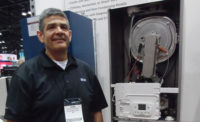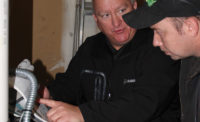However, installing and servicing these sophisticated systems can be more of a challenge for contractors, as they need to have a thorough understanding of hydronics, electrical systems, and electronics. Keeping current on these high-tech boilers usually requires ongoing training and support, which, fortunately, most manufacturers are happy to provide.
Better Modulation, Control
The modulating burner has become very popular on commercial boilers because it can lower the firing rate as the building load decreases, allowing the burner to keep running instead of shutting off, said Jeff Vallett II, boiler product manager, Lochinvar LLC. “This increases the efficiency of the boiler, reduces fuel costs, and reduces maintenance costs. This technology, as well as an 8-inch touch-screen display, is used in our Crest boiler, which features 25:1 modulation turndown.”
Jim Schnorr, president, Thermal Solutions LLC, noted that boilers have evolved into highly efficient and sophisticated units, with burners now available that can turn down to a fraction of what they used to. “Before it was just on or off, all or nothing, and now modulation is the standard, which allows the boiler to run at lower or higher rates matching ever-changing load demand,” he said. “We will offer an enhanced version of this technology on two new product lines that will come out in January. The proper application of these products, though, remains critical to overall system efficiency and end-user satisfaction.”
While some may say that modulating burners are nothing new, the system designs and control strategies that were responsible for operating the boilers when modulation first became available did not effectively take advantage of the modulation capabilities, said Erin Sperry, commercial heating product manager, Fulton Boiler Works Inc. “This includes the ability to better match actual system loads, as well as operate at higher efficiencies at lower operating points and firing rates. With an increasing awareness on overall system design being extremely important to achieving optimal performance of any boiler, there are more opportunities to take advantage of technologies such as modulating burners, which are already on the market.”
New control technologies are particularly important, as they can provide energy-saving benefits similar to a modulating burner, noted Vallett. “A boiler control that can accurately calculate building load will allow the boiler to run for longer periods of time, resulting in higher efficiencies. Control technology also makes it easier for contractors, building engineers, and end users to interact with the boiler, as it lets them see exactly what the boiler is doing. If there is an issue, the boiler control is smart enough to direct the person on-site to the exact cause of the problem.”
Advanced controls, as well as full modulation firing and stainless steel condensing heat exchangers, are new features on Bradford White’s Brute Elite high-efficiency boilers and volume water heaters. “These components work in unison to sense and adapt to the varying needs of the system by modulating the output of single or multiple units,” said Nate Warren, hydronics sales manager, Bradford White Corp. “The integrated controls can eliminate the need for external controls when multiple units are installed, providing a simpler, more practical way to maximize fuel efficiency in the system.”
While modulating burners and advanced control strategies can allow boilers to achieve efficiencies in excess of 95 percent, building owners and operators are also increasingly concerned with the payback associated with installation costs versus operational costs, said Chuck O’Donnell, director of marketing, Laars Heating Systems Co., a subsidiary of Bradford White Corp. “A major factor in operational costs is power consumed via pumping. On a large commercial heating application, pumping electrical costs can pile up quickly. We have developed a variable-speed drive that matches the condensing boiler’s modulation rate with that of a variable-speed pump’s rate. When the boiler modulates down, so will the variable-speed pump. Over time, this can reduce building owners’ electrical bills significantly. It is available now on the Laars NeoTherm and will be on our large input MagnaTherm boiler, which will be released in January.”
Service and Maintenance
There is little question that energy costs are an important issue for building owners and managers, said Warren, and proper installation and maintenance of high-efficiency boilers help ensure that equipment operates at peak efficiency and provides a long, reliable service life. “It plays a big role in generating a return on the building owner’s investment,” he said.
To make sure contractors have the knowledge they need to install and service its high-efficiency boilers, Bradford White operates training centers in Rochester, N.H., and Middleville, Mich., said Warren.
“Our goal is to provide our reps, wholesalers, and professional installers with continuous training on proper application and support of our products in these modern systems,” he said.
Installing a modulating boiler correctly does not just ensure higher efficiencies, it also prevents safety hazards. As O’Donnell noted, “Flue gases must be monitored from low fire through high fire by using a combustion analyzer to ensure carbon dioxide, carbon monoxide, and oxygen are at appropriate levels as outlined in the manufacturer’s instructions. If the combustion setup is not done properly, a boiler can quickly foul and run at an unsafe condition.”
To keep a modulating-condensing boiler running well for many years, an annual inspection is highly recommended. O’Donnell noted that the burner, combustion chamber, flame sensing rods, blowers, proving switches, high temperature limits, and other safeties should be inspected. Items should also be cleaned or replaced per the manufacturer’s recommendations. “By following these steps, a modulating condensing boiler will continue to run at peak efficiencies with minimal downtime.”
Schnorr added that regular service is important because new boilers are not only running more efficiently, but are also more sophisticated, which requires some annual preventive maintenance. “It’s like getting the oil and filters checked in your car — if there is something wrong, you catch it early. A little maintenance can go a long way.”
Ensuring boilers are ignited, maintained, and operated by properly trained, qualified personnel is extremely important, said Sperry, as no two boilers are alike, even if they seem that way. “If an individual is not adequately trained and fluent using a combustion analyzer, multimeter, and in reading and interpreting all aspects of electrical diagrams, as well as having been to a factory-authorized training course for the specific model of boiler being worked with, that individual should not attempt to operate any boiler.”
She added that working with manufacturer representatives is a good option, as they usually have trained engineers and even service technicians on staff, who can ensure that the equipment meets local code requirements and is designed and operated by someone with proper training. To that end, Fulton offers technical service schools year-round, both at their corporate headquarters facility in Pulaski, N.Y., as well as numerous customer locations. “These training programs are hands-on, interactive, and extremely effective at giving individuals the confidence to work independently in the field.”
Lochinvar also keeps installers and maintenance personnel up to speed on boiler installation and preventive maintenance through its Lochinvar University, field training sessions, and a new online training site, www.lochinvaru.com. Lochinvar University, held in Lebanon, Tenn., includes two days of classroom and hands-on training as well as regional field training sessions. Lochinvar U is a self-guided virtual training site that allows users to work at their own pace and keep track of their progress online, said Vallett.
Manufacturers have obviously been busy keeping their dealers trained on all the new features being incorporated into their commercial boilers, and more technology is on the way. According to Schnorr, new players in larger condensing boilers — 6 million Btu and up — will be coming to market soon. “In addition, there is growing interest in hybrid systems, which is the installation of a condensing boiler along with a noncondensing boiler. The condensing boiler runs when low supply temperatures are needed, while the noncondensing boiler takes over when high water temperatures are needed. This arrangement achieves system efficiencies similar to an all-condensing boiler arrangement, while reducing upfront costs as much as 30 percent.”
With new technologies being added and existing technologies being improved upon, end users and contractors alike are sure to appreciate the improved efficiency, comfort, and reliability of today’s commercial boilers.
Publication date: 10/14/2013














